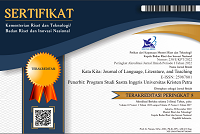THE CONCEPT OF THE LUXURY BRANDING IN SAMSUNG GALAXY S6 EDGE SERIES THROUGH TRIADIC MODES OF SIGN
DOI:
https://doi.org/10.9744/katakita.5.1.142-148Keywords:
Perancangan Visual, fashion, Kain tenun ikat, Kepulauan Tanimbar MalukuAbstract
This thesis mainly deals with the iconisation of signs and naturalisation process in order to reveal the way Samsung Galaxy S6 Edge is naturalised as a luxury product. This thesis also involves analysis of the luxury branding concept through the analysis of a product which conceptualises its advertisement using the concept of luxury identifiers. The focus of the writer’s analysis is the advertisements themselves as the writer will use the triadic modes of signs, naturalisation process, and the concept of luxury identifiers which also involves process of signification, and metaphor in its analysis. Those theories will help the writer in analysing the meaning of the advertisement first, and then figure out the aim of the luxury branding strategy in the product, then figure out how the expressions are used in the luxury concept of advertisement. The writer analyses the advertisement of Samsung Galaxy S6 Edge which was published in 2015. From the analysis, the writer found out that the luxury branding strategy of Samsung Galaxy S6 Edge utilises naturalisation process to naturalise the luxury identity of Samsung Galaxy S6 Edge which is a masstige product. Using that as a basis, the expressions in the advertisement focus on selling the idea that Samsung Galaxy S6 Edge is a luxury product which is an innovative idea designed for professionals and to display superiority within the social group. Samsung Galaxy S6 Edge aims to provide the user with a display of social superiority within the social group through the consumption of Samsung Galaxy S6 Edge. In that regards, the user will be seen as a person who is wealthy, stand out in terms of taste, and a professional who is fully aware of the technology.
References
Adebeshin,K. (2015). Exploring Symbolism in Masstige Brand Advertising Within the Discursive Content of Luxury: A Semiotic Analysis. Unpublished Thesis.Auckland: Auckland University of Technology.
Berthon, P., Pitt, L., Parent, M., & Berthon, J. (2009). Aesthetics and ephemerality: Observing and preserving the luxury brand. California Management Review, 52(1), 45-66. doi: 10.1525/cmr.2009.52.1.45.
Harris, R. (2004). A cognitive psychology of mass communication. London: Lawrence Erlbaum Associates, Inc.
Krippendorff, K. (2004). Content Analysis: an introduction to its methodology 2ed. California: Sage Publication
Peirce, C. (1931–58) Collected Papers (ed. Charles Hartshorne and Paul Weiss, 1932; Burks, 1958; vol. 8, Reviews, Correspondence and Bibliography, ed. William A. Burks,
Percy, L & Elliot, R. (2005). Strategic advertising management. NewYork: Oxford University Press
Schreier, M. (2012). Qualitative Content Analysis in Practice. Los Angeles: SAGE Publications, Ltd.
Tynan, C., McKechnie, S., & Chhuon, C. (2010). Co-creating value for luxury brands. Journal of Business Research, 63(11), 1156-1163.doi: 10.1016/j.jbusres.2009.10.012
Vigneron, F., & Johnson, L. W. (2004). Measuring perceptions of brand luxury. Journal of Brand Management, 11(6), 484–508. doi: 10.1057/palgrave.bm. 2540194
Downloads
Issue
Section
License
Authors who publish with this journal agree to the following terms:- Authors retain copyright and grant the journal right of first publication with the work simultaneously licensed under a Creative Commons Attribution License that allows others to share the work with an acknowledgement of the work's authorship and initial publication in this journal.
- Authors are able to enter into separate, additional contractual arrangements for the non-exclusive distribution of the journal's published version of the work (e.g., post it to an institutional repository or publish it in a book), with an acknowledgement of its initial publication in this journal.
- Authors are permitted and encouraged to post their work online (e.g., in institutional repositories or on their website) prior to and during the submission process, as it can lead to productive exchanges, as well as earlier and greater citation of published work (See The Effect of Open Access).














